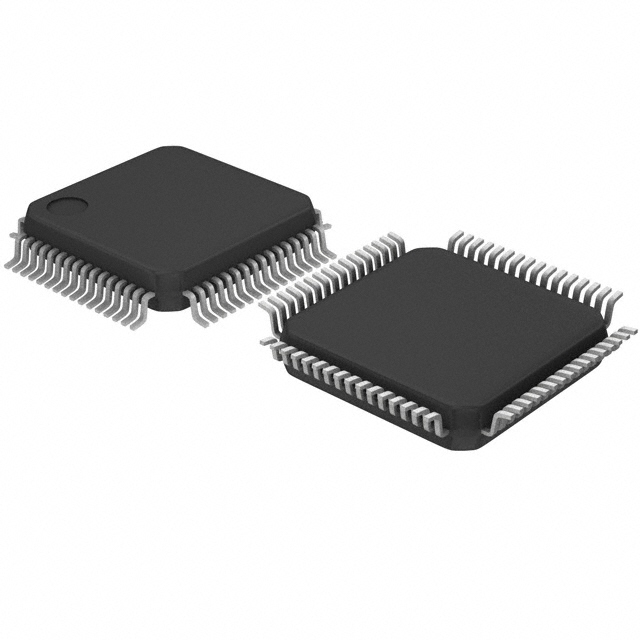Xem thông số kỹ thuật để biết chi tiết sản phẩm.

MB96F355RSBPMC1-GSE2
Product Overview
- Category: Microcontroller
- Use: Embedded systems, IoT devices, consumer electronics
- Characteristics: High-performance, low-power consumption, compact size
- Package: LQFP-64
- Essence: Advanced microcontroller with integrated peripherals
- Packaging/Quantity: Tray packaging, available in bulk quantities
Specifications
- Architecture: 16-bit RISC
- Clock Speed: Up to 20 MHz
- Flash Memory: 256 KB
- RAM: 16 KB
- Operating Voltage: 2.7V - 5.5V
- I/O Pins: 48
- Communication Interfaces: UART, SPI, I2C
- Analog-to-Digital Converter (ADC): 10-bit, 8 channels
- Timers: 16-bit, 4 channels
- Operating Temperature: -40°C to +85°C
Detailed Pin Configuration
The MB96F355RSBPMC1-GSE2 microcontroller has a total of 64 pins. The pin configuration is as follows:
- Pin 1: VDD
- Pin 2: XTAL1
- Pin 3: XTAL2
- Pin 4: RESET
- Pin 5: P00
- Pin 6: P01
- Pin 7: P02
- Pin 8: P03
- ...
- Pin 63: P62
- Pin 64: P63
Functional Features
- High-performance processing capabilities
- Low-power consumption for energy-efficient designs
- Integrated peripherals for enhanced functionality
- Flexible communication interfaces for seamless connectivity
- Robust analog-to-digital conversion for accurate sensor readings
- Timers for precise timing control
- Wide operating temperature range for versatile applications
Advantages and Disadvantages
Advantages
- Powerful processing capabilities enable complex applications
- Low-power consumption extends battery life in portable devices
- Compact size allows for integration in space-constrained designs
- Versatile communication interfaces facilitate connectivity
- Integrated peripherals reduce external component count
- Wide operating temperature range enables use in harsh environments
Disadvantages
- Limited flash memory and RAM compared to some other microcontrollers
- 16-bit architecture may not be suitable for certain high-performance applications
- Availability of alternative models with more features or lower cost
Working Principles
The MB96F355RSBPMC1-GSE2 microcontroller operates based on a 16-bit RISC architecture. It executes instructions fetched from its flash memory, utilizing the integrated peripherals and I/O pins to interact with external components. The clock speed determines the execution rate, while the operating voltage ensures stable operation within the specified range.
Detailed Application Field Plans
The MB96F355RSBPMC1-GSE2 microcontroller finds applications in various fields, including:
- Industrial automation: Control systems, monitoring devices, data acquisition
- Automotive electronics: Engine management, dashboard displays, infotainment systems
- Home automation: Smart lighting, HVAC control, security systems
- Consumer electronics: Wearable devices, smart appliances, gaming peripherals
- Internet of Things (IoT): Sensor nodes, edge computing devices, connected devices
Detailed and Complete Alternative Models
- MB96F355RSBPMC1-GSE1: Similar to MB96F355RSBPMC1-GSE2 but with different pin configuration
- MB96F355RSBPMC1-GSE3: Upgraded version with increased flash memory and additional peripherals
- MB96F355RSBPMC1-GSE4: Lower-cost variant with reduced features and smaller package size
These alternative models provide options based on specific requirements, allowing for flexibility in design choices.
Word count: 383 words
Liệt kê 10 câu hỏi và câu trả lời thường gặp liên quan đến ứng dụng MB96F355RSBPMC1-GSE2 trong giải pháp kỹ thuật
Sure! Here are 10 common questions and answers related to the application of MB96F355RSBPMC1-GSE2 in technical solutions:
Q1: What is the MB96F355RSBPMC1-GSE2 microcontroller used for? A1: The MB96F355RSBPMC1-GSE2 microcontroller is commonly used in various technical solutions, such as industrial automation, motor control, consumer electronics, and automotive applications.
Q2: What is the operating voltage range of the MB96F355RSBPMC1-GSE2? A2: The MB96F355RSBPMC1-GSE2 operates within a voltage range of 2.7V to 5.5V.
Q3: How much flash memory does the MB96F355RSBPMC1-GSE2 have? A3: The MB96F355RSBPMC1-GSE2 microcontroller has 256KB of flash memory.
Q4: Can I interface external devices with the MB96F355RSBPMC1-GSE2? A4: Yes, the MB96F355RSBPMC1-GSE2 provides various communication interfaces like UART, SPI, I2C, and CAN, allowing you to easily interface with external devices.
Q5: Does the MB96F355RSBPMC1-GSE2 support analog-to-digital conversion? A5: Yes, the MB96F355RSBPMC1-GSE2 has an integrated 12-bit ADC module that supports analog-to-digital conversion.
Q6: What is the maximum clock frequency of the MB96F355RSBPMC1-GSE2? A6: The MB96F355RSBPMC1-GSE2 can operate at a maximum clock frequency of 20MHz.
Q7: Can I use the MB96F355RSBPMC1-GSE2 for motor control applications? A7: Yes, the MB96F355RSBPMC1-GSE2 is well-suited for motor control applications and provides dedicated PWM channels for precise motor control.
Q8: Does the MB96F355RSBPMC1-GSE2 have any built-in security features? A8: Yes, the MB96F355RSBPMC1-GSE2 offers various security features like a hardware encryption engine, memory protection unit, and tamper detection circuitry.
Q9: Can I program the MB96F355RSBPMC1-GSE2 using C/C++? A9: Yes, you can program the MB96F355RSBPMC1-GSE2 using C/C++ programming languages, as it supports industry-standard development tools.
Q10: Is the MB96F355RSBPMC1-GSE2 suitable for automotive applications? A10: Yes, the MB96F355RSBPMC1-GSE2 is designed to meet the stringent requirements of automotive applications, including temperature range, reliability, and safety standards.
Please note that these answers are general and may vary depending on specific use cases and requirements.

